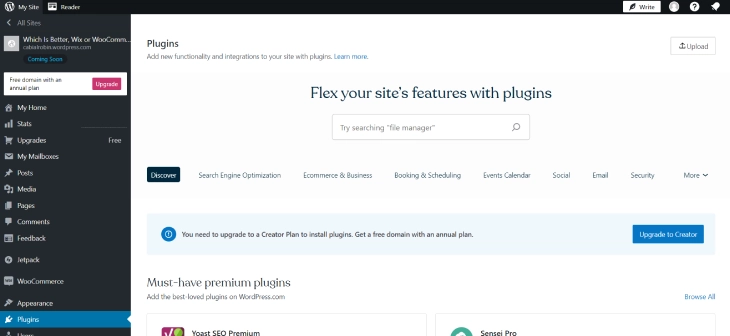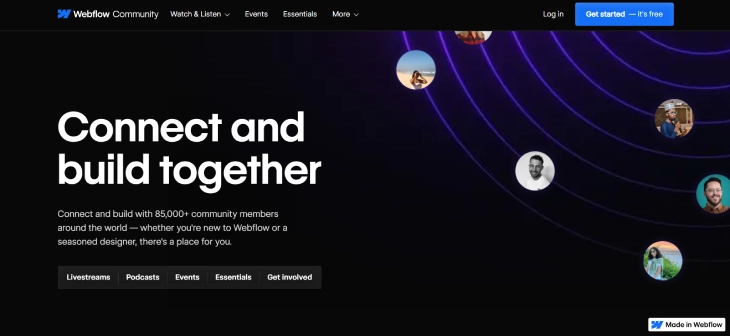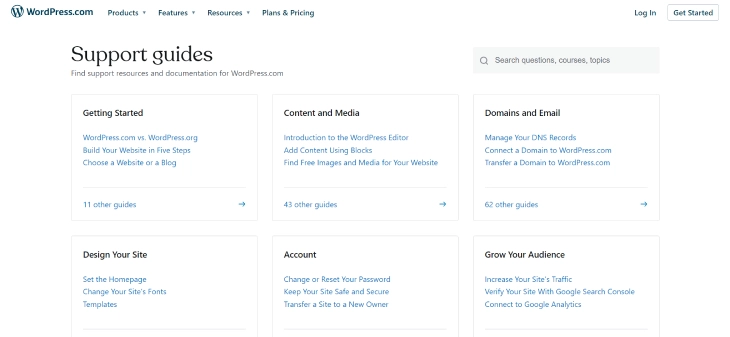
Choosing the right website builder can make or break your project. Wix, Webflow, WordPress, and Squarespace are among the top contenders, each with its tools and features. Wix is celebrated for its drag-and-drop simplicity, making it a go-to for beginners. Webflow appeals to those with more technical know-how, offering more nuanced control over design. WordPress, with its extensive plugin ecosystem, provides unmatched flexibility and customization options, catering to a wide range of users from bloggers to businesses. Squarespace rounds out the group with its stylish templates and intuitive design interface, perfect for creatives and small business owners looking for a polished web presence.
This post looks closely at what Wix, Webflow, WordPress, and Squarespace offer, comparing their strengths and areas where they could be better. By examining each platform's offerings, from design flexibility to SEO tools, it provides a comprehensive review that highlights what each service brings to the table. Whether launching a first blog, scaling an online store, or showcasing a portfolio, understanding these platforms can help build a strong foundation for any website creation.
Wix Vs. Webflow Vs. WordPress Vs. Squarespace: Comparative Overview
Choosing between Wix, Webflow, WordPress, and Squarespace depends on your specific needs and skill level, as each platform caters to different users. Wix is the most user-friendly and affordable option. At the same time, Webflow offers advanced design flexibility for professional designers, WordPress provides the most control with its extensive themes and plugins, and Squarespace is ideal for creatives seeking stylish designs.
Here's a comparative overview of these four website builders:
|
Price |
Ease of Use |
Design and Customization |
Features and Functionality |
Customer Support |
|
|
Wix |
$4.50 per month |
|
|
|
|
|
Webflow |
$18.00 per month |
|
|
|
|
|
WordPress |
$8.87 per month |
|
|
|
|
| Squarespace |
$22.92 per month |
|
|
|
|
Pricing and Value: Wix, Webflow, WordPress, or Squarespace
Wix is the most affordable option, offering a free plan and budget-friendly pricing. At the same time, Squarespace has higher pricing but provides stunning designs, and WordPress is free but requires payment for additional features. Webflow has higher pricing than Wix but offers advanced design features.
Pricing Plans: Overview
Wix, Webflow, WordPress, and Squarespace all offer different pricing plans to fit a range of budgets and needs.
Here's an overview of the pricing plans for each platform.
|
Free |
Connect Domain |
Combo |
Unlimited |
VIP |
|
|
Wix |
$0.00 per month |
$4.50 per month |
$8.50 per month |
$12.50 per month |
$24.50 per month |
|
Starter |
Basic |
CMS |
Business |
Enterprise |
|
|
Webflow |
$0.00 per month |
$18.00 per month (billed monthly) |
$29.00 per month (billed monthly) |
$49.00 per month (billed monthly) |
Contact Webflow |
|
Starter |
Explorer |
Creator |
Entrepreneur |
Cloud |
|
|
WordPress |
$8.87 per month (Save 68% by paying annually) |
$15.96 per month (Save 63% by paying annually) |
$33.69 per month (Save 50% by paying annually) |
$56.74 per month (Save 47% by paying annually) |
$65.00 per month (Starting at $64.99/month billed annually, excl. taxes) |
|
Free |
Personal |
Business |
Commerce (Basic) |
Commerce (Advanced) |
|
|
Squarespace |
$0.00 per month (Free for 14 days) |
$22.92 per month (Save 31% annually) |
$32.33 per month (Save 29% annually) |
$35.35 per month (Save 25% annually) |
$65.55 per month (Save 24% annually) |
Wix offers a free plan with limited features and premium plans ranging from $8.50 to $24.50 per month, with the most popular plan being the Unlimited plan for $12.50 per month.
Wix and Webflow offer a free plan and several paid plans, with Wix's prices ranging from $4.50 to $24.50 per month and Webflow's prices ranging from $18 to $49 per month, with an enterprise plan available upon request. Webflow's plans offer more features and customization than Wix's plans, but Wix's plans are more affordable. Wix and Webflow provide discounts for annual plans and a 14-day money-back guarantee.
Squarespace doesn't have a free plan but offers a 14-day free trial, and its pricing plans range from $22.92 to $65.55 per month, with the Personal plan being the most basic at $12 per month.
WordPress is free, but hosting fees, premium themes, and plugins may cost extra, ranging from $8.87 to $65.00 per month, depending on the provider and plan.
It's essential to consider what features and customization options are necessary for your website when comparing pricing plans and determining which platform is right for you.
Value of Money
Consider your website's needs and desired features when determining the best platform for your budget.
Wix offers a range of budget-friendly plans, including a free option, suitable for beginners, with advanced features like eCommerce and custom domain available in premium plans, though some functionalities may require higher-tier plans.

When comparing Wix and Webflow's value for money, Webflow's plans, though more expensive, include more features and customization, catering to professional designers and agencies creating complex websites.

WordPress is free but requires hosting and potential additional expenses and upgrades for premium themes or plugins, offering unparalleled flexibility and control over site design backed by a vast community and resources.

Squarespace provides pricier plans but includes stylish templates and extensive customization options, ideal for online selling, and excellent customer service.

Ease of Use: Wix, Webflow, WordPress, or Squarespace
Wix and Squarespace are recognized for their intuitive interfaces, enabling beginners to create and personalize their websites effortlessly. On the other hand, Webflow and WordPress present a more challenging learning curve, providing extensive customization possibilities that may require some technical expertise.
Drag-and-Drop Editors
Wix offers a highly intuitive drag-and-drop editor that allows users to add and arrange elements on their pages easily, making it an ideal choice for beginners.

Webflow's drag-and-drop editor is more complex and better suited for those with design experience, as it offers greater flexibility and customization options.
WordPress does not have a native drag-and-drop editor, but users can install third-party plugins like Elementor or Divi to add this functionality. These plugins offer extensive customization options, but users may need some technical knowledge to use them effectively.
Squarespace's drag-and-drop editor is also user-friendly, but it is not as flexible as Wix's editor, and users may find it limiting in terms of customization options.
Site Navigation and Editing
Wix's site navigation and editing interface is easy to use, allowing users to find and edit needed elements. Webflow's site navigation and editing interface is more complex, but it offers greater flexibility and customization options.
WordPress has a more traditional dashboard interface, which may require some time to learn but provides extensive customization options. Squarespace's interface is also user-friendly, but it may take some time to get used to.
Design and Customization: Wix, Webflow, WordPress, or Squarespace
Wix and Squarespace offer mobile-responsive and customizable templates. Webflow provides greater design flexibility for complex animations and interactions, and WordPress has extensive design options through its library of themes and plugins but may require coding knowledge.
Templates
Wix offers a wide range of free templates that are mobile-responsive and highly customizable, making it easy for users to create a professional-looking website. The templates cover a variety of industries, from restaurants to online stores, and are constantly updated to keep up with design trends.

Webflow's templates are more limited than Wix's, but they are highly customizable and designed for specific industries, such as tech startups and creative agencies. The templates use HTML, CSS, and JavaScript, allowing for greater design flexibility and complex animations.

WordPress uses themes instead of templates. It has a huge library of free and premium themes, ranging from simple blog designs to complex e-commerce layouts. The themes are highly customizable, but users may need some technical knowledge to install and configure them manually.

Squarespace's templates are mobile-responsive and highly customizable, focusing on modern and minimalist design. The templates cover a variety of industries, from photography to fashion, and are designed to showcase visual content. The templates are also optimized for SEO, making them a popular choice for businesses and creatives alike.

Design Flexibility
Wix offers a high degree of design flexibility, allowing users to customize their website's layout, colors, fonts, and more. Users can also add animations and effects to their website without any coding knowledge.
Webflow provides even greater design flexibility than Wix, enabling users to create complex animations, interactions, and custom layouts. Webflow's design tools are more advanced and may require some design skills to use effectively.
WordPress offers a vast selection of themes and plugins for customizing your site's appearance, with more options available to those who know a bit of coding. This flexibility makes it a powerful tool for personalizing your website space.
Squarespace is geared towards modern, sleek designs, allowing easy tweaks to your site's layout and style. While it's straightforward and optimized for mobile and SEO, it may not offer the same level of customization as platforms like Wix or Webflow.
Features and Functionality: Wix, Webflow, WordPress, or Squarespace
Wix is ideal for beginners, offering an intuitive drag-and-drop interface with a wide variety of templates and apps for any website type. Webflow caters to those with a design or development background, blending visual editing with coding for precise control over websites.
WordPress is the most flexible, supporting extensive customization through themes and plugins for users ranging from hobbyists to professionals. Squarespace focuses on easy-to-use, stylish templates for a professional-looking website without needing to code.
eCommerce
Wix eCommerce offers a range of features, including product pages, shopping carts, and payment processing. Wix's eCommerce plans also include abandoned cart recovery and the ability to sell on social media channels.

Webflow offers eCommerce functionality by integrating with third-party platforms like Shopify and Foxy. Webflow's eCommerce features include custom product pages, shopping carts, and payment processing.

WordPress offers extensive eCommerce functionality through its WooCommerce plugin. WooCommerce allows users to create an online store, manage inventory, and accept payments. WooCommerce also offers a range of extensions for shipping, taxes, and more.

Squarespace offers built-in eCommerce functionality, including product pages, shopping carts, and payment processing. Squarespace's eCommerce plans also include abandoned cart recovery and the ability to sell on social media channels. Squarespace's eCommerce features are optimized for mobile devices and offer a smooth checkout experience.

SEO
Wix offers built-in SEO features, such as customizable meta tags, URL structures, and sitemaps. Wix also provides SEO guidance through its Wix SEO Wiz tool, which helps users optimize their websites for search engines.
Webflow offers advanced SEO functionality, including customizable meta tags, URL structures, and sitemaps. Webflow also allows users to add alt tags to images, set up 301 redirects, and customize schema markup.

WordPress offers extensive SEO customization options through its vast library of plugins. Plugins like Yoast SEO and All in One SEO Pack provide users with advanced SEO features like customizable meta tags, XML sitemaps, and schema markup.
Squarespace offers built-in SEO features, such as customizable meta tags, URL structures, and sitemaps. Squarespace also provides users with SEO guidance through its SEO Checklist, which helps users optimize their website for search engines. Squarespace's templates are optimized for SEO and mobile devices, providing a smooth user experience.

Third-Party Integrations
Wix offers a range of third-party integrations, including payment gateways, social media platforms, and marketing tools. Wix's App Market allows users to add functionality to their website, such as live chat, booking systems, and email marketing.

Webflow offers a range of third-party integrations, including payment gateways, analytics tools, and marketing platforms. Webflow's Integrations page allows connecting users' websites with third-party services like Mailchimp, Google Analytics, and Zapier.

WordPress offers extensive third-party integration options through its vast library of plugins. Plugins like Gravity Forms, WPForms, and Jetpack allow users to add functionality to their website, such as contact forms, payment gateways, and social media sharing.

Squarespace offers a range of third-party integrations, including payment gateways, social media platforms, and marketing tools. Squarespace's Extensions page allows users to add functionality to their website, such as shipping calculators, appointment scheduling, and email marketing.
Customer Support: Wix, Webflow, WordPress, or Squarespace
Wix offers phone, email, and chat support, a comprehensive knowledge base, and a community forum. Webflow provides email and chat support, a help center, and a community forum. WordPress offers community-based support through forums and documentation, while Squarespace provides 24/7 email support, live chat during business hours, and a comprehensive knowledge base.
Support Channel
Wix offers phone, email, and chat support, a comprehensive knowledge base, and a community forum. Users can access support through the Wix Editor or the Wix Help Center.

Webflow offers email and chat support, a help center, and a community forum. Users can access support through the Webflow Editor or the Webflow Help Center.

WordPress offers community-based support through forums and documentation. Users can access support through the WordPress.org support forums or the WordPress.org Support section.

Squarespace offers 24/7 email support, a live chat during business hours, and a comprehensive knowledge base. Users can access support through the Squarespace Editor or the Squarespace Help Center.
Support Quality
Wix's support quality is generally positive, with users reporting helpful and knowledgeable support agents. Webflow's support quality is also generally positive, with users reporting helpful and knowledgeable support agents.
WordPress's support quality is community-based, and the quality of support can vary depending on the expertise of the community members. Squarespace's support quality is generally positive, with users reporting helpful and knowledgeable support agents. The 24/7 email support and live chat during business hours provide users with quick and convenient access to support.
Conclusion: Which Is Better - Wix, Webflow, WordPress, or Squarespace?
Choosing the best website builder depends on the user's specific requirements and preferences. Wix stands out for beginners and those valuing ease of use and affordability, whereas Webflow appeals to professional designers and agencies needing advanced design flexibility.
WordPress is a favorite among bloggers and businesses for its extensive customization through a huge selection of themes and plugins. Squarespace suits creatives and small businesses looking for modern, minimalist design and strong eCommerce features. Each platform shines in different areas, making it important for users to assess their particular needs and objectives when selecting a website builder.
* read the rest of the post and open up an offer